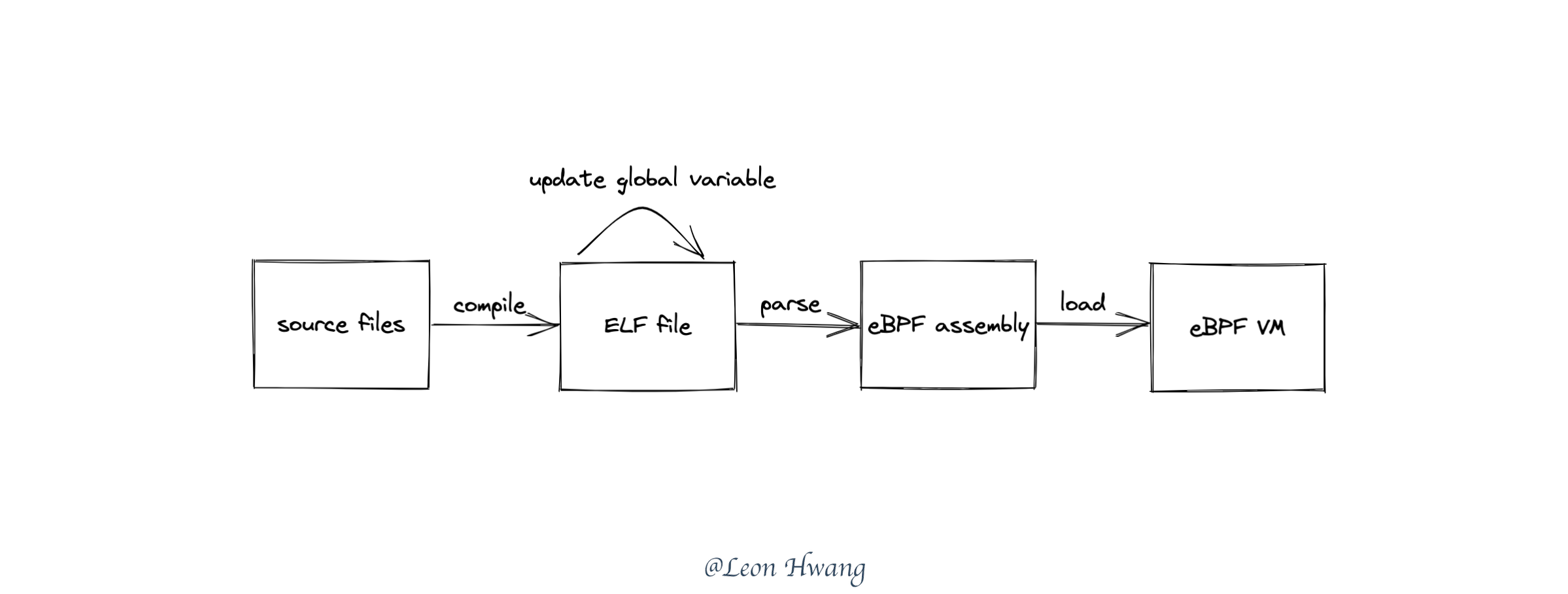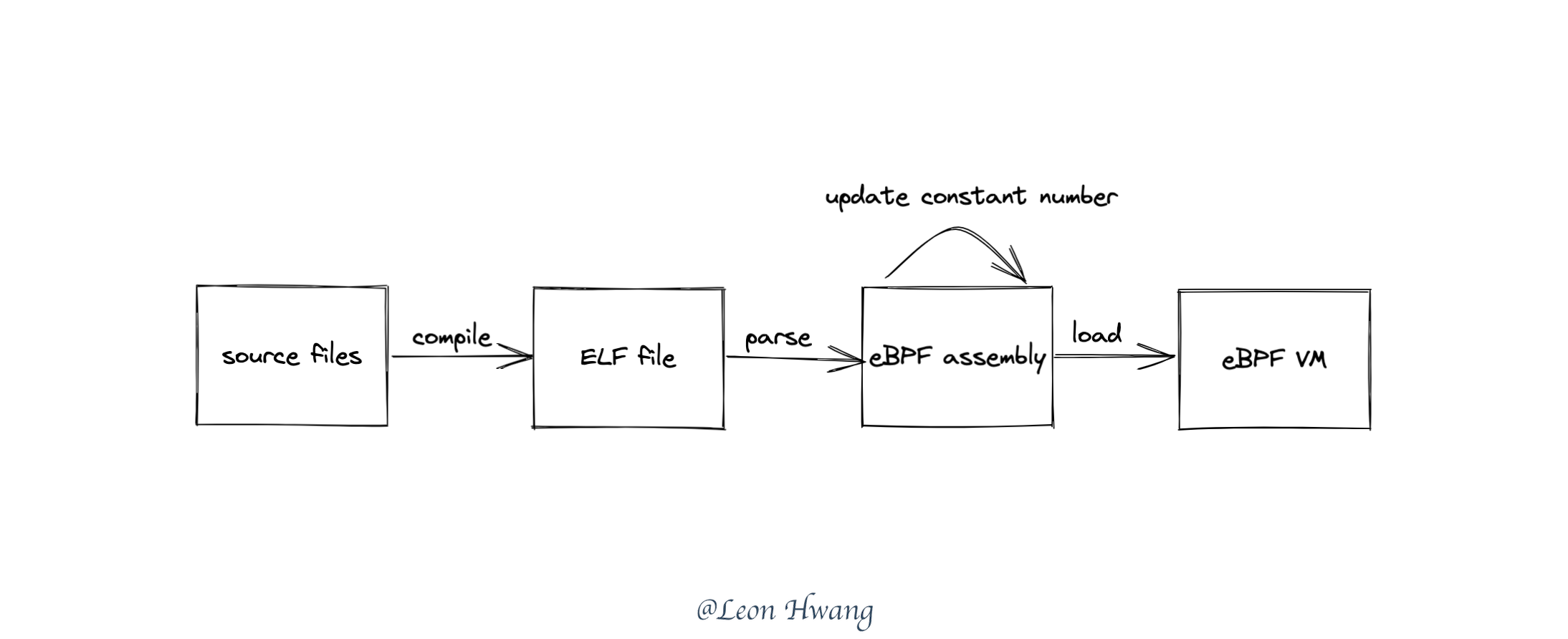在 Kubernetes 集群环境下,如果跨节点的 Pod 需要组成多个 VPC 网络,使用 eBPF 的时候,该如何在 CNI 层面动态地为每个 Pod 分配 VXLAN VNI 或者 VLAN ID 呢?
一个简单可行的办法是,每次 CNI 为 Pod 挂载 eBPF 程序的时候,都去重新编译 eBPF 程序。这样一来,就可以动态地向 eBPF 程序注入 VXLAN VNI 或者 VLAN ID 了。
可是,这办法会导致每次都需要生成新的 eBPF 源代码、运行 clang 命令行去编译。由此可知,CNI 需要为每个 Pod 都进行文件操作、命令行执行;这些处理都会带来性能损耗、时间损耗、更低的稳定性。
有没有像 CO-RE 那样只需要一次编译、还可以动态注入 VXLAN VNI 或者 VLAN ID 的办法呢?
下面的试验以 ping 为例,动态注入 VXLAN VNI 或者 VLAN ID 也可以采用同样的办法。
全局变量法
全局变量的办法,指的是 eBPF 程序里使用全局变量,然后使用工具去变更 eBPF 程序 ELF 文件里的全局变量。
在 Linux 系统里,clang 编译 eBPF 程序得到的文件格式是 ELF。而在 ELF 文件里,使用工具能够变更其中的全局变量的值。参考 On self-modifying executables in Go。
原理如下图:

以下为试验代码。
1
2
3
4
5
6
7
8
9
10
11
12
13
14
15
16
17
18
19
|
__u32 target_addr = 0xFEDCBA98;
SEC("egress")
int filter_out(void *skb) {
struct iphdr iph;
if (bpf_skb_load_bytes_relative(skb, 0, &iph, sizeof(iph),
BPF_HDR_START_NET) < 0)
return TC_ACT_OK;
if (iph.protocol != IPPROTO_ICMP) return TC_ACT_OK;
bpf_printk("from ebpf inject-global-var, 0x%08X -> 0x%08X, target 0x%08X\n",
iph.saddr, iph.daddr, target_addr);
if (iph.daddr == target_addr) return TC_ACT_SHOT;
return TC_ACT_OK;
}
|
可以通过以下方式修改 ELF 文件里的 target_addr 变量。
1
2
3
4
5
6
7
8
9
10
11
12
13
14
15
16
17
18
19
20
21
22
23
24
25
26
27
28
29
30
|
func (e *entry) put(data []byte, val uint32, bo binary.ByteOrder) {
data = data[e.off:]
switch e.val.(type) {
case uint8:
data[0] = byte(val)
case uint16:
bo.PutUint16(data[:2], uint16(val))
case uint32:
bo.PutUint32(data[:4], val)
case uint64:
bo.PutUint64(data[:8], uint64(val))
}
}
func getEntry(f *elf.File, name string) (*entry, error) {
syms := must(f.Symbols())
for _, s := range syms {
if s.Name == name {
sect := f.Sections[s.Section]
bs, _ := sect.Data()
varOff := s.Value - sect.Addr
var e entry
e.off = sect.Offset + varOff
e.get(bs[varOff:], s.Size, f.ByteOrder)
return &e, nil
}
}
return nil, fmt.Errorf("can't find symbol '%s'", name)
}
|
完整代码请参考:ebpf-inject-global-var
效果如下:

常量替换法
常量替换的办法,指的是在 eBPF 程序里使用某个特定的常量当作占位符,然后在 Go 程序里解析 eBPF 程序的 ELF 文件后得到 eBPF 汇编之后,将 eBPF 汇编里的那个特定的常量替换为一个新的值。
相比 动态变更全局变量 办法,该办法能够规避因全局变量而带来的内核版本不兼容性(更严格的 eBPF verifier 可能会禁止使用全局变量)。但是对于一个工程而言,该办法在工程上的实践并不友好。
原理如下图:

以下为试验代码:
1
2
3
4
5
6
7
8
9
10
11
12
13
14
15
16
17
18
19
20
|
#define target_addr 0xFEDCBA98
SEC("egress")
int filter_out(void *skb) {
struct iphdr iph;
if (bpf_skb_load_bytes_relative(skb, 0, &iph, sizeof(iph),
BPF_HDR_START_NET) < 0)
return TC_ACT_OK;
if (iph.protocol != IPPROTO_ICMP) return TC_ACT_OK;
bpf_printk(
"from ebpf inject-replace-const, 0x%08X -> 0x%08X, target 0x%08X\n",
iph.saddr, iph.daddr, target_addr);
if (iph.daddr == target_addr) return TC_ACT_SHOT;
return TC_ACT_OK;
}
|
然后在解析 eBPF 程序的 ELF 文件后,替换 eBPF 汇编里的特定常量。
1
2
3
4
5
6
7
8
9
10
11
12
13
14
15
16
17
18
19
20
21
22
23
24
25
26
27
28
29
|
func attachBpfProg(ifindex int, targetAddr uint32, data []byte) error {
var bpfObj struct {
Prog *ebpf.Program `ebpf:"filter_out"`
}
bpfSpec, err := ebpf.LoadCollectionSpecFromReader(bytes.NewReader(data))
if err != nil {
return err
}
for _, prog := range bpfSpec.Programs {
prog.Type = ebpf.SchedCLS
}
// update target address
for _, prog := range bpfSpec.Programs {
for i := range prog.Instructions {
if prog.Instructions[i].Constant == 0xFEDCBA98 {
prog.Instructions[i].Constant = int64(targetAddr)
}
}
}
if err := bpfSpec.LoadAndAssign(&bpfObj, nil); err != nil {
return err
}
return attachTcEgress(ifindex, bpfObj.Prog.FD())
}
|
完整代码请参考:ebpf-inject-replace-const
效果如下:

实验环境
1
2
3
4
5
6
7
8
9
|
# lsb_release -a
No LSB modules are available.
Distributor ID: Ubuntu
Description: Ubuntu 21.10
Release: 21.10
Codename: impish
# uname -a
Linux vultr 5.13.0-28-generic #31-Ubuntu SMP Thu Jan 13 17:41:06 UTC 2022 x86_64 x86_64 x86_64 GNU/Linux
|
小结
绞尽脑汁,终于想到这些“黑魔法”来达成目标。
而能够想到这些办法的背后,就是要对使用 cilium/ebpf 加载 eBPF 程序的过程比较了解、对 eBPF 程序的编译、加载、运行有所了解。
总结
大胆设想,小心求证。这是本次研究的最大心得。
研究的思想不囿于开发时的常规思维,需要在了解相关知识的前提下去大胆地设想解决办法。如若没有一定的知识积累,断然很难想到这些“黑魔法”。





